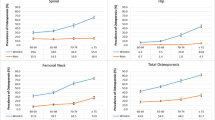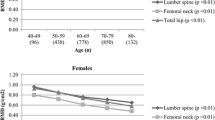Abstract
Introduction
This study aimed to clarify the trends in the prevalence of osteoporosis among general inhabitants using population-based cohort data of the baseline and the survey 10 years later.
Materials and Methods
The baseline survey of the Research on Osteoarthritis/Osteoporosis Against Disability (ROAD) study was conducted in 2005–2007; 1690 participants (596 men, 1094 women, mean age 65.2 years) completed all examinations of osteoporosis, including a questionnaire of medical information in the present/past and bone mineral density measurement using dual-energy absorptiometry. The fourth survey was performed in 2015–2016; 1906 individuals (637 men, 1269 women, 65.0 years) completed assessments identical to those at the baseline survey. Osteoporosis was defined using the World Health Organization criteria.
Results
The prevalence of lumbar spine (L2–L4) osteoporosis at the baseline survey was 13.6% (men, 3.4%; women, 19.2%) and that at the fourth survey was 9.7% (men, 1.4%; women, 13.9%), which decreased significantly (p < 0.01), while that of the femoral neck was not significantly different between the baseline and fourth surveys. Regarding the prevalence of osteoporosis of L2–L4 or the femoral neck, the prevalence of osteoporosis in women aged ≥ 70 was 38.8% at the fourth survey and 48.9% at the baseline study; thus, the prevalence at the fourth survey was significantly lower than that at the baseline survey (p < 0.01).
Conclusions
In the population-based survey with a 10-year interval, the prevalence of osteoporosis at lumbar spine tended to decrease significantly. This preferable change in osteoporosis could contribute to the decrease in the occurrence of osteoporotic fracture in the future.

Similar content being viewed by others
Availability of data and material
Not applicable.
Code availability
Not applicable.
References
Cabinet Office, Japan. Reiwa 1st Year White Paper on Aging Society (Overall Version) https://www8.cao.go.jp/kourei/whitepaper/w-2019/zenbun/01pdf_index.html. Accessed 15 Mar 2022 (Japanese)
Ministry of Health, Labour and Welfare, Japan. The outline of the results of National Livelihood Survey 2019. https://www.mhlw.go.jp/toukei/saikin/hw/k-tyosa/k-tyosa19 Accessed 15 Mar 2022 (Japanese)
Yoshimura N, Muraki S, Oka H, Mabuchi A, En-Yo Y, Yoshida M, Saika A, Yoshida H, Suzuki T, Yamamoto S, Ishibashi H, Kawaguchi H, Nakamura K, Akune T (2009) Prevalence of knee osteoarthritis, lumbar spondylosis and osteoporosis in Japanese men and women: the research on osteoarthritis/osteoporosis against disability study. J Bone Miner Metab 27:620–628. https://doi.org/10.1007/s00774-009-0080-8
Statistics Bureau of Japan. Population Census 2005. https://www.stat.go.jp/english/data/kokusei/2005/outline.html Accessed 15 Mar 2022
Committee for 2011 Guidelines for Prevention and Treatment of Osteoporosis (Director, Orimo H) (2011) The guidelines for prevention and treatment of osteoporosis. Life Science Publishing Co. Ltd, Tokyo
Orimo H, Hayashi Y, Fukunaga M, Sone T, Fujiwara S, Shiraki M, Kushida K, Miyamoto S, Soen S, Nishimura J, Oh-Hashi Y, Hosoi T, Gorai I, Tanaka H, Igai T, Kishimoto H, Osteoporosis Diagnostic Criteria Review Committee: Japanese Society for Bone and Mineral Research (2001) Diagnostic criteria for primary osteoporosis: year 2000 revision. J Bone Miner Metab 19:331–337. https://doi.org/10.1007/s007740170001
Committee for 2015 Guidelines for Prevention and Treatment of Osteoporosis (Director, Orimo H) (2015) The guidelines for prevention and treatment of osteoporosis. Life Science Publishing Co. Ltd, Tokyo
World Health Organization (1994) Assessment of fracture risk and its application to screening for postmenopausal osteoporosis. Report of a WHO Study Group. World Health Organ Tech Rep Ser 843:1–129
Kanis JA, Adachi JD, Cooper C, Clark P, Cummings SR, Diaz-Curiel M, Harvey N, Hiligsmann M, Papaioannou A, Pierroz DD, Silverman SL, Szulc P, Epidemiology and Quality of Life Working Group of IOF (2013) Standardising the descriptive epidemiology of osteoporosis: recommendations from the Epidemiology and Quality of Life Working Group of IOF. Osteoporos Int 24:2763–2764
Yoshimura N, Muraki S, Oka H, Kawaguchi H, Nakamura K, Akune T (2010) Cohort profile: research on osteoarthritis/osteoporosis against disability study. Int J Epidemiol 39:988–995
Yoshimura N, Kakimoto T, Nishioka M, Kishi T, Iwasaki H, Niwa T, Morioka S, Sakata T, Hashimoto T (1997) Evaluation of reproducibility of bone mineral density measured by dual energy X-ray absorptiometry (Lunar DPX-L). J Wakayama Med Soc 48:461–466
Statistics Bureau of Japan. Population Census 2015. https://www.stat.go.jp/english/data/kokusei/2015/summary.html. Accessed 15 Mar 2022
Cabinet Office. 2018 White paper on aging society. https://www8.cao.go.jp/kourei/whitepaper/w-2018/html/zenbun/s1_1_1.html. Accessed 15 Mar 2022
Hernlund E, Svedbom A, Ivergård M, Compston J, Cooper C, Stenmark J, McCloskey EV, Jönsson B, Kanis JA (2013) Osteoporosis in the European Union: medical management, epidemiology and economic burden. A report prepared in collaboration with the International Osteoporosis Foundation (IOF) and the European Federation of Pharmaceutical Industry Associations (EFPIA). Arch Osteoporos 8:136. https://doi.org/10.1007/s11657-013-0136-1
Wright NC, Looker AC, Saag KG, Curtis JR, Delzell ES, Randall S, Dawson-Huges B (2014) The recent prevalence of osteoporosis and low bone mass in the United States based on bone mineral density at the femoral neck or lumbar spine. Bone Miner Res 29:2520–2526. https://doi.org/10.1002/jbmr.2269
Chen FP, Huang TS, Fu TS, Sun CC, Chao AS, Tsai TL (2018) Secular trends in incidence of osteoporosis in Taiwan: a nationwide population-based study. Biomed J 41:314–320. https://doi.org/10.1016/j.bj.2018.08.001
Looker A, Borrud LG, Dawson-Hughes B, Shepherd JA, Wright NC (2012) Osteoporosis or low bone mass at the femur neck or lumbar spine in older adults: United States, 2005–2008. NCHS Data Brief 1–8
Ministry of Health, Labour and Welfare, Japan. The outline of the National Health and Nutrition Examination Survey 2005. https://www.mhlw.go.jp/bunya/kenkou/eiyou07/01.html. Accessed 15 Mar 2022 (Japanese)
Ministry of Health, Labour and Welfare, Japan. The outline of the National Health and Nutrition Examination Survey 2015. https://www.mhlw.go.jp/bunya/kenkou/eiyou/h27-houkoku.html. Accessed 15 Mar 2022 (Japanese)
National Institute of Health and Nutrition, Japan. Current status of national nutrition, 1955. https://www.nibiohn.go.jp/eiken/chosa/kokumin_eiyou/1955.html. Accessed 15 Mar 2022 (Japanese)
National Institute of Health and Nutrition, Japan. Current status of national nutrition, 1965. https://www.nibiohn.go.jp/eiken/chosa/kokumin_eiyou/1965.html. Accessed 15 Mar 2022 (Japanese)
Acknowledgements
The authors wish to thank Dr Naoki Hirabayashi of Kawakami Clinic, Hidakagawa Town; Mrs Tomoko Takijiri, Mrs Rie Takiguchi, Mrs Kyoko Maeda, Ms Ikuyo Ueyama, Mrs Michiko Mori, Mrs Hisayo Sugimoto, and other members of the public office in Hidakagawa Town; and Mrs Tamako Tsutsumi, Mrs Kanami Maeda, Mrs Megumi Takino, Mrs Shuko Okada, Mrs Kazuyo Setoh, Mrs Chise Ryouno, Mrs Miki Shimosaki, Mrs Chika Yamaguchi, Mrs Yuki Shimoji, and other members of the public office in Taiji Town for their assistance in locating and scheduling the participants for examinations. We would also like to thank Mrs Kyoko Hattori, Mrs Toki Sakurai, Mrs Saeko Sahara, and Mr Noriyuki Oe for their assistance with data reduction and administration.
Funding
This work was supported by a Grant-in-Aid funding from the Ministry of Health, Labour and Welfare: H17-Men-eki-009 (Director, Kozo Nakamura), H20-Choujyu-009 (Director, Noriko Yoshimura), H23-Choujyu-002 (Director, Toru Akune), H25-Choujyu-007 (Director, Noriko Yoshimura), H25-Nanchitou (Men)-005 (Director, Sakae Tanaka), 19FA1401 (Director, Sakae Tanaka), 19FA1007, 20JA1001 (Director, Hiroyuki Oka), 19FA1017 (Director, Etsuo Chosa), 19FB1001 (Director, Yutaka Osuga), 21FA1006 (Director, Hiroshi Yamada), and 22FA1009 (Director, Sakae Tanaka). The study was also supported by Scientific Research grants B19H03895, B26293139, B23390172, and B20390182, and Challenging Exploratory Research grants 21K19631, 18K18447, 15K15219, and 24659317 to Noriko Yoshimura; Scientific Research grants B26293331, B23390356, and C20591774 and Challenging Exploratory Research grants 26670307 and 23659580 to Shigeyuki Muraki; Challenging Exploratory Research grants 24659666 and 21659349 and Young Scientists A18689031 to Hiroyuki Oka; Scientific Research grants B26293329, B23390357, and C20591737 and Challenging Exploratory Research grant 25670293 to Toru Akune; Scientific Research grant S50282661 to Sakae Tanaka; Scientific Research grant B18H03164 to Yosuke Yamada; Challenging Exploratory Research grant C18K09122 to Harumoto Yamada; and by Collaborating Research with NSF from the Ministry of Education, Culture, Sports, Science and Technology in Japan 08033011–00262 (Director, Noriko Yoshimura). The study was partly supported by grants from the Japan Agency for Medical Research and Development (17dk0110028h0001, Director, Noriko Yoshimura; 17gk0210007h0003, 19gk0210018h0002, and 22gk0210034h0001, Director, Sakae Tanaka; 22dk0110047h0001, Director, Kanae Mure). Further, the study was partly supported by grants from the Japan Osteoporosis Society (Noriko Yoshimura, Chiaki Horii, Shigeyuki Muraki, Hiroyuki Oka, and Toru Akune) and Japan Osteoporosis Foundation (2015, Noriko Yoshimura) and research aids from the Japanese Orthopaedic Association (JOA-Subsidized Science Project Research 2006-1 and 2010-2, Director, Hiroshi Kawaguchi; and 2014-1, Director, Kozo Nakamura), the Japanese Society for Musculoskeletal Medicine (2015, Director, Shigeyuki Muraki; and 2017, Director, Noriko Yoshimura), Mitsui Sumitomo Insurance Welfare Foundation (2016, Director, Noriko Yoshimura), and Japan Dairy Association (2017, Director, Noriko Yoshimura).
Author information
Authors and Affiliations
Contributions
NY made substantial contributions to the study concept, design, and protocol, data collection and screening, statistical analyses, data interpretation, and drafting of the paper or revising it critically for important intellectual content. TS and CH made substantial contributions to the study design and protocol, data collection and screening, and revising the draft critically for important intellectual content. SM and HO made substantial contributions to the study design and protocol, data collection and screening, statistical analyses, and data interpretation. HK, KZ, TA, and ST made substantial contributions to the study concept, design, and protocol, data interpretation, drafting of the paper or revising it critically for important intellectual content. All authors had full access to all study data and had final responsibility in the decision to submit for publication.
Corresponding author
Ethics declarations
Conflict of interest
All authors have no conflicts of interest.
Ethics approval
The study was conducted with the approval of the ethics committees of the University of Tokyo (No. 1264 and No. 1326) and the University of Wakayama Medical University (No. 373).
Consent to participate
All participants provided written informed consent.
Consent for publication
All participants gave informed consent for publication of the results of the ROAD study, without any personal information.
Additional information
Publisher's Note
Springer Nature remains neutral with regard to jurisdictional claims in published maps and institutional affiliations.
About this article
Cite this article
Yoshimura, N., Iidaka, T., Horii, C. et al. Trends in osteoporosis prevalence over a 10-year period in Japan: the ROAD study 2005–2015. J Bone Miner Metab 40, 829–838 (2022). https://doi.org/10.1007/s00774-022-01352-4
Received:
Accepted:
Published:
Issue Date:
DOI: https://doi.org/10.1007/s00774-022-01352-4




